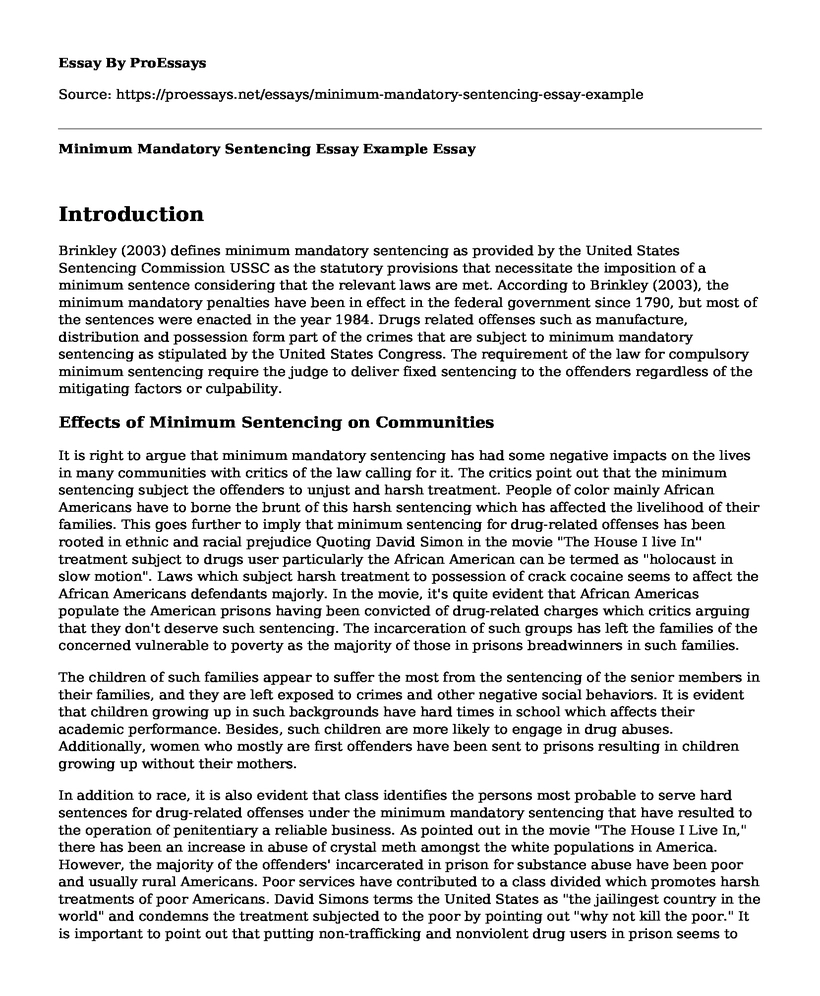Introduction
Brinkley (2003) defines minimum mandatory sentencing as provided by the United States Sentencing Commission USSC as the statutory provisions that necessitate the imposition of a minimum sentence considering that the relevant laws are met. According to Brinkley (2003), the minimum mandatory penalties have been in effect in the federal government since 1790, but most of the sentences were enacted in the year 1984. Drugs related offenses such as manufacture, distribution and possession form part of the crimes that are subject to minimum mandatory sentencing as stipulated by the United States Congress. The requirement of the law for compulsory minimum sentencing require the judge to deliver fixed sentencing to the offenders regardless of the mitigating factors or culpability.
Effects of Minimum Sentencing on Communities
It is right to argue that minimum mandatory sentencing has had some negative impacts on the lives in many communities with critics of the law calling for it. The critics point out that the minimum sentencing subject the offenders to unjust and harsh treatment. People of color mainly African Americans have to borne the brunt of this harsh sentencing which has affected the livelihood of their families. This goes further to imply that minimum sentencing for drug-related offenses has been rooted in ethnic and racial prejudice Quoting David Simon in the movie "The House I live In'' treatment subject to drugs user particularly the African American can be termed as "holocaust in slow motion". Laws which subject harsh treatment to possession of crack cocaine seems to affect the African Americans defendants majorly. In the movie, it's quite evident that African Americas populate the American prisons having been convicted of drug-related charges which critics arguing that they don't deserve such sentencing. The incarceration of such groups has left the families of the concerned vulnerable to poverty as the majority of those in prisons breadwinners in such families.
The children of such families appear to suffer the most from the sentencing of the senior members in their families, and they are left exposed to crimes and other negative social behaviors. It is evident that children growing up in such backgrounds have hard times in school which affects their academic performance. Besides, such children are more likely to engage in drug abuses. Additionally, women who mostly are first offenders have been sent to prisons resulting in children growing up without their mothers.
In addition to race, it is also evident that class identifies the persons most probable to serve hard sentences for drug-related offenses under the minimum mandatory sentencing that have resulted to the operation of penitentiary a reliable business. As pointed out in the movie "The House I Live In," there has been an increase in abuse of crystal meth amongst the white populations in America. However, the majority of the offenders' incarcerated in prison for substance abuse have been poor and usually rural Americans. Poor services have contributed to a class divided which promotes harsh treatments of poor Americans. David Simons terms the United States as "the jailingest country in the world" and condemns the treatment subjected to the poor by pointing out "why not kill the poor." It is important to point out that putting non-trafficking and nonviolent drug users in prison seems to serve no purpose and only costs the taxpayers money which could be utilized to rehabilitate the affected families as well as community development.
Minimum mandatory sentences have, therefore, led to prisons overcrowding with people who committed minor but drug-related offenses. Overcrowding in prisons as a result of minimum mandatory sentences results to increased health risks to the inmates as well as safety for staff, inmates, and the community. This has resulted in heightened unrest, inadequate programming, and insufficient treatment and rehabilitation in addition to high recidivism. Additionally, overcrowding in prisons due to such sentencing makes it challenging to run the penitentiary which can also lead to failure of systems such as sewage system leading to pollution which adversely affects the surrounding communities (Barton -Bellesa, 2012).
Family strain in communities experiencing high rates of incarcerations has been evident. The stress in the family relationship could be attributed to emotional and economic sacrifices as a result of the imprisonment. The strain affects the reintegration of the personnel back into the communities and potentially contributes to the offenders resulting back to drug abuse that rendering the jail ineffective in curbing the vice (Barton -Bellesa, 2012).
Minimum Mandatory Sentencing for Drug Offenses
The minimum mandatory sentences subjected to drug offenders were introduced in the United States after Congress passed the ADA Act of 1986 and that of 1988. The 1986 act introduced minimum sentencing for first-time offenders with, for instance, a five to forty years sentencing mandated without parole for the first time for persons convicted of possession and distribution of small quantities. The amendments enacted on the anti-abuse act of 1988 resulted in the increased sentencing of the offenders with even smaller amounts. At the time of passing the law, minimum mandatory sentencing was seen as the best of deterrent which aimed at longtime incapacitation (Brikley, 2013).
References
Barton -Bellesa, S.M. (2012). Encyclopedia of community corrections. Thousand Oaks. Calif: SAGE.
Brikley, L.V. (2003). Mandatory minimum sentencing: Overview and background. Hauppauge, NY: Novinka
Cite this page
Minimum Mandatory Sentencing Essay Example. (2022, Sep 11). Retrieved from https://proessays.net/essays/minimum-mandatory-sentencing-essay-example
If you are the original author of this essay and no longer wish to have it published on the ProEssays website, please click below to request its removal:
- The Lamb to the Slaughter Critical Essay
- Essay Example on Glaucon's Argument Against Socrates on Justice in Plato's Republic
- Is Poverty a Crime? Examining Barbara Ehrenreich's NYT Piece
- Essay on Affordable Healthcare Act: Healthcare System Reforms & Overhauls
- Essay Sample on Criminal Justice Reform: An Overview of the ACLU's Efforts
- Essay on Police Use Precision Immobilization Technique to Stop Road Crime
- Essay Example on Predatory Crime: A Dualistic Relationship of Conflict & Consensus







